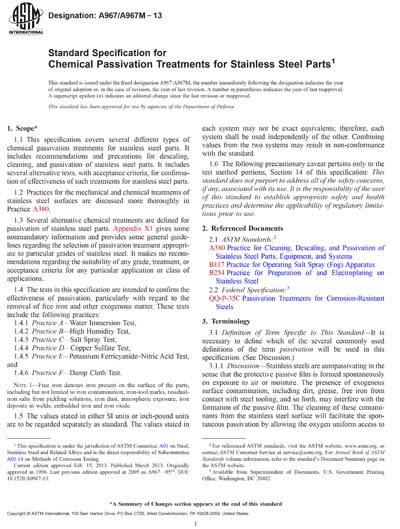Historical
ASTM A967/A967M-13
Standard Specification for Chemical Passivation Treatments for Stainless Steel Parts
1.1 This specification covers several different types of chemical passivation treatments for stainless steel parts. It includes recommendations and precautions for descaling, cleaning, and passivation of stainless steel parts. It includes several alternative tests, with acceptance criteria, for confirmation of effectiveness of such treatments for stainless steel parts.
1.2 Practices for the mechanical and chemical treatments of stainless steel surfaces are discussed more thoroughly in Practice A380.
1.3 Several alternative chemical treatments are defined for passivation of stainless steel parts. Appendix X1 gives some nonmandatory information and provides some general guidelines regarding the selection of passivation treatment appropriate to particular grades of stainless steel. It makes no recommendations regarding the suitability of any grade, treatment, or acceptance criteria for any particular application or class of applications.
1.4 The tests in this specification are intended to confirm the effectiveness of passivation, particularly with regard to the removal of free iron and other exogenous matter. These tests include the following practices:
1.5 The values stated in either SI units or inch-pound units are to be regarded separately as standard. The values stated in each system may not be exact equivalents; therefore, each system shall be used independently of the other. Combining values from the two systems may result in non-conformance with the standard.
1.6 The following precautionary caveat pertains only to the test method portions, Section 14 of this specification: This standard does not purport to address all of the safety concerns, if any, associated with its use. It is the responsibility of the user of this standard to establish appropriate safety and health practices and determine the applicability of regulatory limitations prior to use.
ASTM International [astm]

